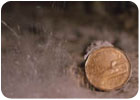
Our region (Carolinas) has had an extreme amount of rain/moisture in the last year. This was preceded by about five years of drought conditions. The result is people are experiencing water or waterproofing problems they have never seen before now. Fifteen-year-old houses that never showed signs of problems are springing leaks.
One solution: Crystalline waterproofing. Crystalline technology has been around for more than 30 years. Originally developed in Germany, this concept of waterproofing has proven itself in construction of dams, treatment plants, tunnels and buildings. So yes, it can certainly be utilized to address problems in basement walls and slabs, retaining walls and many other residential applications.
There are several options to consider when addressing your specific problem. Often, access to the source of water is key. How do you locate this source in a cost affective way, that doesn't disrupt or make a mess of your home and its surroundings? Often crystalline technology can be your simplest and most effective solution.
Commonly, crystalline waterproofing products are mixed with water and brush-applied to prepped concrete (block) surfaces. When applied to concrete, the crystal chemicals react with the water and cement and are absorbed into the concrete by capillary action.

There are additional benefits beyond the ability to self-seal. One prominent advantage over traditional waterproofing, is the ability to apply crystalline products to either the positive or negative side of walls. Again, since they permeate and become part of the concrete, application side does not matter. Thus, avoid digging up the yard to find and fix the problem. The next key advantage is that it is immune to damage. Other systems can fail due to punctures or tears. But with crystalline being integral there is no surface coating to be of concern. And finally, integral crystalline waterproofing is permanent, while many other systems deteriorate over time.
If you read this article, please circle number 326.

Report Abusive Comment